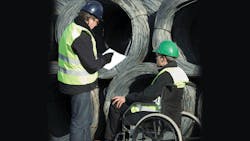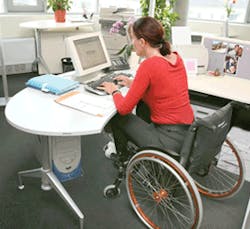Employees in today’s workplace face many challenges. Work forces have been cut, and in many cases, workdays have been extended. Older workers are unable to retire, while younger workers are unable to find work. New technology is introduced into the workplace, requiring all to relearn how to perform their jobs. This is difficult for the average worker, but it is extremely difficult if an employee is further hindered by disabilities.
Disabilities of all types affect employees and can pose various mental or physical challenges. In many situations, a disability may impact the amount of time it takes for an employee to complete a task or get from one part of a facility to another. Some disabilities may be known while others remain unknown to an employer. Thanks to the Americans with Disabilities Act (ADA), employees with disabilities can continue to work without fear of losing their jobs1.
All employees with disabilities deserve the right to support their families. If otherwise qualified for a job, a disability should not take away an individual’s opportunity to work. Existing laws protected those discriminated against for race, sex, national origin and color, but the ADA was the first law to speak for those with disabilities in the workplace.
The ADA disallows discrimination against otherwise qualified individuals in an employment setting because of mental or physical disabilities2. This means that in many situations, the employer has to adjust a work environment to allow an employee to function. In 2009, the ADA was amended to include additional information and coverage. This amendment required the Equal Employment Opportunity Commission (EEOC) to make changes to their regulations regarding the term “substantially limits” and how it is defined2. It also broadens the definition of “major life activities” to include many new activities.
Workplace Adaptations
As with any law that changes the workplace, some fight or avoid it while others fully embrace and promote it. One major compliance concern deals with accessibility. Because of this, many workplaces have adjusted or created more accessible entrances and exits to their facilities, allowing more independence for persons in wheelchairs. Other subtle changes may include the height of water fountains, width of bathroom stalls, hand rails inside the stalls and long ramps instead of stairs. The path of travel that employees take should never be obstructed; there should be no barriers to prevent someone from getting to safety in an emergency3.
Making accommodations in the workplace is important, yet one must avoid making a spectacle of employees with disabilities. One concept being utilized in workplaces is universal design, which is best defined as designing products and work spaces to allow use by everyone, regardless of disability4. This eliminates many cases of employees standing out or requiring special assistance to be able to complete their tasks. Better designed work spaces can increase function for all employees, regardless of age4. This still is a relatively new idea and few examples exist in the workplace despite multiple studies proving the effectiveness.
Workstations easily can be adapted to follow this universal design. Many companies now use slide-out keyboard trays and monitors on swinging arms to allow employees to adjust to their needs. Desks can accommodate wheelchairs in place of regular chairs, and general work spaces can be lowered to allow easier access. All workplaces eventually will follow the universal design approach3. The main goal is to remove all barriers and allow everyone to concentrate more on completing their tasks.
The biggest challenge with universal design is accommodating the multitude of challenges that different disabilities present. Not all disabilities are the same, and not all will present the same challenges for employees. Some employees may have issues with their right hand while others have issues with their left. For some, it may involve not being able to stand or sit. Some may need low lighting, while others need bright lighting. Designing a facility to accommodate all is always going to be a challenge.
Some disabilities require a service animal to be able to get around or reach materials. ADA protects those that need such animals. This can create another complication for an employer if other employees are allergic to such animals. The employer must work with all parties involved to find a solution.
Companies using older facilities often have the most trouble complying with guidelines of the ADA. Designing a building from the ground up is much easier than attempting to retrofit existing facilities. Some of the complications with retrofitting facilities include adding adequate doorways. Depending on the design of the structure, adding doorways can be complicated and require an extensive amount of remodeling. Other complications include retrofitting areas with stairs and restrooms with stalls that are too narrow. Moving plumbing may require the existing floor to be torn out and require a lot of time.
OSHA Compliance
The bottom line is that employers must create a safe and healthy workplace for all employees regardless of disability, sex, race, origin, etc. Employees have the right to work in an environment free from recognizable hazards as well as free from hazards that may not be easily recognizable. The goal for all employers should be for each employee to return home safely at the end of each shift.
Complying with OSHA guidelines can be more difficult in regards to employees with disabilities. This difficulty lies with ensuring that employees are aware of all hazards in the workplace. Multiple disabilities will create multiple reasons that may keep employees from recognizing hazards. Employees with impaired vision, for example, must have other means of identifying hazards. This may be remedied with audible alarms or touch-activated devices that warn employees not to go in an area. Other employees may have difficulties reading and may benefit from shapes or colors to further identify hazardous areas. For workers who lack hearing ability, employers can utilize signs to demonstrate hazards or use flashing strobes to identify when employees need to evacuate an area and head to safety.
The Safety Professional’s Challenge
Safety professionals must have a good understanding of the ADA and how it impacts their jobs2. Something that may be safe for most employees may not be safe for someone with a disability.
Safety professionals often are involved in workers’ compensation because it deals directly with an injury that occurs in the workplace. An employee is entitled to coverage if an injury arises out of and in the course of employment5. This is regardless of fault as long as the employment of the individual is what led to the incident. Even if the employee was working outside of the scope of his task, the employer must cover the costs associated with the injury. Benefits include money to cover lost wages and paid hospital bills, as well as other medical and rehabilitation treatment5. For this reason, safety professionals must be concerned with pre-existing conditions and create a work environment that in no way aggravates those conditions.
Many companies are concerned with controlling experienced modification rates (EMR), which are directly related to how much a company pays for insurance versus how much money an insurance company must pay out in coverage. If an employee is injured to the point that he cannot return to work, the amount paid out may increase significantly. This greatly can impact subcontractors who depend on low EMRs to continue being invited to job bids. Companies with a high EMR may no longer be allowed to bid on work, thus affecting the future of a company.
For some employees with disabilities, it may be necessary to provide restricted duty programs. These programs may control the type of work conducted by the employee, the length of time the employee works without breaks, the amount of energy it takes for an employee to complete a task and the length of time it takes for an employee to complete a task. Safety professionals often are expected to not only oversee restricted work programs, but also to determine what type of work falls into specific categories. The last thing an employer needs is for an employee to get hurt because they should not be working in a full-load position. Employees may be in a restricted work program for a short period of time or they may be hired on at that capacity. Employees participating in a restricted work program must understand that they cannot perform whatever task they choose.
Enabling Learning
Safety professionals also are tasked with making sure all employees understand the company’s policies and procedures. Disabilities may impact an employee’s way of learning. For this reason, training may need to be conducted in multiple ways to make sure all employees understand. Testing of the training may have to be offered in writing and verbally to appropriately test all individuals. Safety professionals must be able to show documentation of training, and employees must be able to demonstrate an understanding of what is expected in the workplace.
Additionally, safety professionals must keep up with laws as they continue to be molded in the court system2. Interpretations of the law may change what is required for all locations. Employees with disabilities have a right to a safe work environment, and it often is up to the safety professional to make sure it exists.
The ADA required many changes in the workplace to ensure employee safety. Complying with these requirements is not always easy, and in many situations, compliance falls on the shoulders of the safety professional. Discrimination has no place in the workplace, but until it disappears entirely, guidelines will continue to be developed. It’s the safety professional’s job to ensure every employee, disabled or not, is safe.
Brandon Emmick has been in the safety field for 10 years, and has an M.S. in safety, security and emergency management from Eastern Kentucky University. He is an OSHA outreach instructor for construction, and has 4 years of experience in construction environments and 3 years of experience in industrial environments. He recently founded the Web site http://www.safefortomorrow.com, with a goal of highlighting safety in all aspects of life and increasing the awareness level of what taking a chance could mean.
References
1Americans With Disabilities Act of 1990, As Amended, 42 U.S.C.A, 12101 et seq. (West 1993).
2Schneid T.D. (2011). Labor and employment issues for the safety professional. Boca Raton, FL: CRC Press.
3Anderson, S. D., Rivers, J. R., Appleton, G. W., & Goel, M. (1995). Americans with Disabilities Act: Issues for Design and Facility Managers. Journal of Management in Engineering, 11(1), 38. Retrieved from EBSCOhost.
4Zolna, J. S., Sanford, J., Sabata, D., & Goldthwaite, J. (2007). Review of accommodation strategies in the workplace for persons with mobility and dexterity impairments: Application to criteria for universal design. Technology & Disability, 19(4), 189-198. Retrieved from EBSCOhost.
5Larson, L. K., Larson, A. (2008). Workers compensation law: Cases, materials and text. New York: LEXIS Pub.

